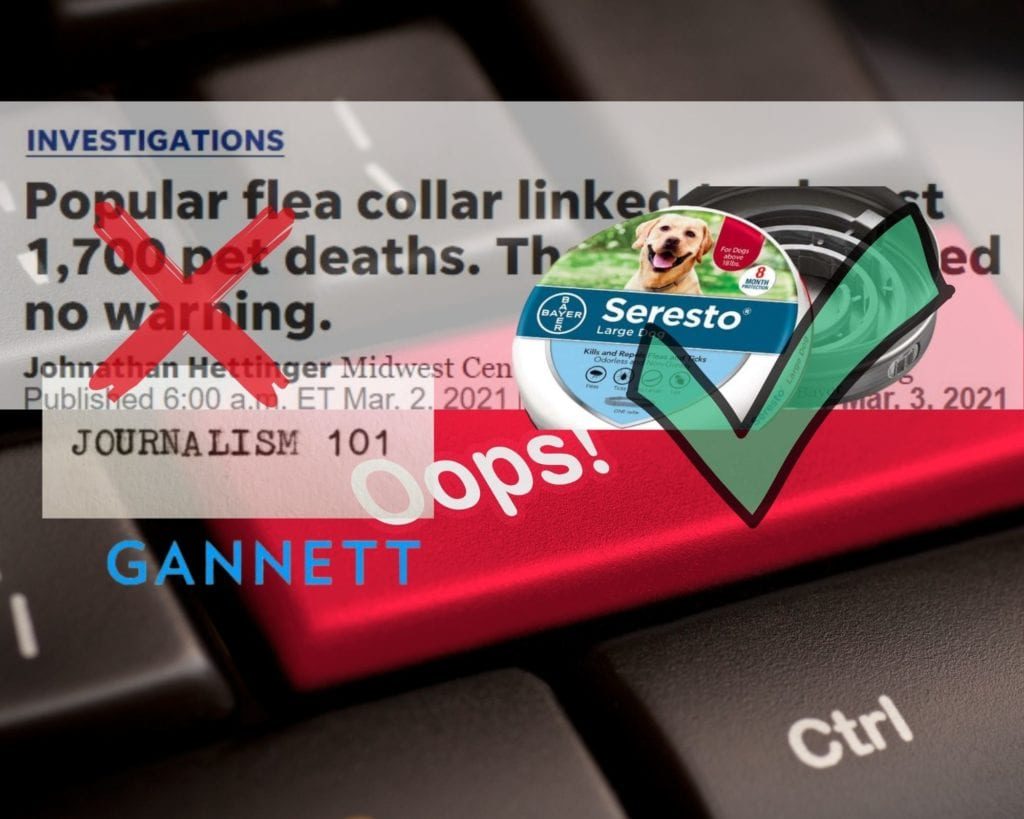Gannett, USA Today editors still mum on disputed Seresto report as writer doubles down
It’s been one week since the Internet was set ablaze by a story about Seresto flea and tick collars, which we dubbed COLLARGATE because of criticism from veterinarians and what we saw as holes in the reporting and editing process.
Last Tuesday, March 2, the editors at America’s largest newspaper chain, Gannett, hit “Publish” on the report.
Since then, the stock of Elanco, which sells Seresto, has recovered about half of the eight percent it dropped that day. But Gannett’s view of the company hasn’t noticeably changed.
Outsourcing reporting, accountability
The Seresto story extrapolated from raw EPA data about incident reports to allege that Elanco fatally poisoned almost 1,700 cats and dogs with its popular Seresto flea and tick collars. The report, published by USA Today, was produced in conjunction with a little-known enterprise, the Midwest Center for “Investigative” Reporting. Based on Gannett’s response to TCR since, it seems that the giant newspaper chain has outsourced not only the reporting to this group but also any accountability for its shortcomings.
The story was contested from the moment it was published, with Elanco disputing it throughout last week. According to Colleen Dekker, a spokeswoman for Elanco, the company has also now formally requested a correction.
Pass the buck
Gannett’s President of News and USA Today publisher Maribel Perez Wadsworth, USA Today Editor-in-Chief Nicole Carroll, Executive Vice President of News and Investigations Christopher Davis, and Managing Editor for Standards and Ethics Michael McCarter all declined multiple requests from TCR to respond to questions when reached by email. The editors would not answer whether they were contemplating any updates, clarifications, or corrections to reporter Johnathan Hettinger’s story. These editors also declined multiple requests to respond when asked if they thought, in retrospect, they should have disclosed that Hettinger, the writer, is a colleague of two of his three named “expert” sources. And they declined multiple requests to respond when asked if, in retrospect, given the significant skepticism with which veterinarians have reacted to the story, they now think Hettinger should have consulted veterinarians before concluding that the collars were killers.
Executive Vice President for News and Investigations Christopher Davis told TCR the editors had already answered the questions we posed, which was not accurate. Mr. Davis then advised that we redirect our questions to editors at Midwest, where Gannett is now apparently outsourcing, well, everything. Per Mr. Davis, we reached out to Pamela Dempsey at Midwest, several times. Ms. Dempsey also did not respond to our questions.
COLLARGATE continues with an Amazon twist
Meantime, Hettinger is continuing to appear on Gannett bylines, and the material continues to be misleading, if not inaccurate. Three days following the Seresto story, Hettinger wrote a story alleging that Amazon had put Seresto collars under formal review in response to his reporting, and that news of the review came from an “announcement” as he characterized it.
Amazon, the world’s largest online retailer, said this week it will consider whether to continue selling Seresto flea-and-tick collars after media reports that they have been linked to more than 75,000 pet injuries and almost 1,700 pet deaths.
The announcement came after the Midwest Center for Investigative Reporting and USA TODAY exposed the large number of complaints the U.S. Environmental Protection Agency received about the collars, which use pesticides to kill ticks and fleas.
Amazon, where the Seresto collar is the top-selling flea and tick collar, said the company is “looking into the product in question,” spokeswoman Mary Kate McCarthy said.
In the first paragraph, Hettinger characterizes a statement from Amazon spokeswoman Mary Kate McCarthy as an “announcement.” That’s patently misleading, if not inaccurate. The language was provided in response to Hettinger’s inquiry; it was not an “announcement” which suggests that Amazon has placed Seresto collars under formal review following his story. Moreover, this is boilerplate language that Amazon regularly issues to media when initial inquiries are made about the safety of a particular product. To say that Amazon ‘announced’ implies a proactive action on the company’s part when, in fact, no such language exists.
In other words, this appears to be an attempt to provide padding for the earlier story, now being contested by Elanco and under a cloud of criticism from veterinarians. By saying that Amazon is deciding whether to stop selling the collars because of his reporting, Hettinger is doubling down – and Gannett is providing him a forum to do so.
However, Elanco spokeswoman Keri McGrath says that Hettinger did not, at any point, ask Elanco for comment regarding the Amazon ‘announcement.’
“Speaking of friends [including one of his three named expert sources] doing dope shit, here’s a story I wrote about the Yellowstone Gateway Busines Coalition, many of whom I consider my friends”
In what appears to be a long pattern of one-sided attack pieces in which large corporations are villainized, Hettinger’s website offers his views on the topics his reporting covers: climate change, environmental politics, and policy – and it’s the kind of warning sign that one would have hoped would catch the attention of an editor at Gannett, especially given the extent to which the opinion writing on his blog intersects directly with the topics he’s “reporting” about. At one point, he even references “friends doing dope shit” and subsequently quotes Mr. Donley, one of the three named “expert” sources in the Seresto story (there is no disclosure to readers that Donley and Hettinger are colleagues).
That Gannett has become reliant on people who are aligned with causes to do the work that used to be done by professional journalists is no surprise. The once-dominant newspaper chain has gone through rounds of layoffs in the last decade as the newspaper industry has fallen victim to the Internet, though a handful of newspaper businesses that embraced online payment platforms early on, such as The New York Times and Wall Street Journal, have done relatively well.

